An Improved Optimization Function to Integrate the User’s Comfort Perception into a Smart Home Controller Based on Particle Swarm Optimization and Fuzzy Logic
Abstract
1. Introduction
- Introduction of a novel residential comfort function capable of integrating parameters associated with the human perceptions of temperature and humidity.
- Proposal of a multi-objective SHC model that relies on PSO for scheduling the residential loads and integrates the proposed comfort function by means of fuzzy logic.
- Supplemental materials are available at GitHub® through https://github.com/jonathacosta/SmartGrid/tree/main/SCC-SHC accessed on 15 February 2023, including our source codes, allowing prompt reproduction of our results.
2. Demand-Side Management (DSM)
2.1. Smart Home Controllers (SHCs)
2.2. Comfort Analysis Strategy
3. Computer Algorithms
3.1. Principles of Fuzzy Sets and Logic
3.1.1. Formalization
3.1.2. Application
3.2. Principles of Particle Swarm Optimization (PSO)
3.2.1. Formalization
- A
- The population of particles
- The position vector of particle i in the solution space
- f
- The evaluation function (fitness)
- The velocity vector of particle i
- The vector of the best individual position of particle i, corresponding to the position in the search space where particle i has the best value of the evaluation function f.
- The vector of the best global position of the particle, corresponding to the position that provides the best value among all .
3.2.2. Updating Individual and Global Best Positions
3.2.3. Updating the Velocity and Position of a Particle
3.2.4. Application
4. Proposed Method: Holistic Architecture
4.1. SHC Structure Diagram
4.2. Mathematical Modeling
4.2.1. Cost Model—f
4.2.2. Comfort Model—f
4.2.3. Fuzzification of Comfort Relevance Level
4.3. Comfort Fuzzification Model
- If and , or if and , then
- If and , then
- If and , or if and , then
- fz-comf: employs fuzzy variables to assign a new value to the comfort relevance level according to Equation (15)—user’s perceptions.
- nfz-comf: a fixed value for the comfort relevance level is used, which is specified by the user when registering the loads in the SHC—user’s preferences.
- PSO & fz-comf: the algorithm introduced in this paper, combining PSO and the comfort function proposed.
- PSO & fz-tag-comf: the algorithm presented in this paper combining PSO and the comfort function proposed in [25], with the addition of fuzzy comfort (fz-comf).
4.4. Multi-Objective SHC Function
| Algorithm 1: Pseudocode of SHC based on fuzzy logic |
| Input :Loads, Tariff(T), Population(P), Iterations(It), c1, c2 Output: gBest 1 begin 2 for do 3 if then 4 ; 5 pop ← iniPop(Loads) 6 fitness ← calcFitness() 7 Determine pbest and gbest 8 9 /*Convergence*/ 10 while & output = 0 do 11 w = diw_InertialTechnique() 12 for do 13 if then 14 ; 15 16 if then 17 ; 18 r2 19 Update and 20 21 if then 22 if then 23 /* Restart P keeping the current gbest as the worst solution */ ; 24 ; 25 ; 26 27 else 28 /*Convergence*/ 29 |
5. Results
5.1. Simulation Scenarios and Analysis Criteria
5.1.1. Simulation Parameters
5.1.2. Analysis Criteria
5.2. Analysis of Comfort Relevance Level
5.3. Analysis of Residential Scenarios
5.3.1. ToU Scenario com
5.3.2. ToU Scenario com
5.3.3. ToU Scenario com
6. Discussion
Overview and Other Possible Scenarios
7. Conclusions
Author Contributions
Funding
Institutional Review Board Statement
Informed Consent Statement
Data Availability Statement
Conflicts of Interest
Abbreviations
| DAP | day-ahead price |
| CPP | critical peak pricing |
| RTP | real-time price |
| FP | flat price |
| CT | conventional tariff |
| DG | distributed generation |
| LSSW | load schedule sliding window |
| LP | linear programming |
| ILP | integer linear programming |
| MINLP | mixed-integer nonlinear programming |
| MILP | mixed-integer linear programming |
| BPSO | binary particle swarm optimization |
| TLGO | teacher learning genetic optimization |
| TLBO | teacher learning-based optimization |
| GA | genetic algorithm |
| PSO | particle swarm optimization |
| FL | fuzzy logic |
| SA | simulated anneling |
| ACO | ant colony optimization |
| MOGWO | multi-objective grey wolf optimization |
| IoT | internet of things |
| HIC | home interactive interface |
| DR | demand response |
| ToU | time-of-use |
| SSM | supply-side management |
| DSM | demand-side management |
| SG | smart grid |
| RH | relative humidity |
| OOP | object-oriented programming |
| SHC | smart home controller |
| HVAC | heating, ventilation, and air conditioning |
| ABNT | Brazilian Association of Technical Standards |
| ASHRAE | American Society of Heating, Refrigerating, and Air Conditioning Engineers |
| fz-comf | fuzzy comfort |
| nfz-comf | non-fuzzy comfort |
| ESS | energy storage system |
| EV | electric vehicle |
| PMV | predicted mean vote |
References
- ANEEL [Agência Nacional de Energia Elétrica]. Resolução Normativa N° 414, de 9 de setembro, 2010. Estabelece as Condições Gerais de Fornecimento de Energia Elétrica de Forma Atualizada e Consolidada. Available online: https://www.camara.leg.br/proposicoesWeb/prop_mostrarintegra?codteor=1259869 (accessed on 15 February 2023).
- Esther, B.P.; Kumar, K.S. A survey on residential demand side management architecture, approaches, optimization models and methods. Renew. Sustain. Energy Rev. 2016, 59, 342–351. [Google Scholar] [CrossRef]
- Di Giorgio, A.; Pimpinella, L. An event driven smart home controller enabling consumer economic saving and automated demand side management. Appl. Energy 2012, 96, 92–103. [Google Scholar] [CrossRef]
- Bezerra Filho, P.; Albuquerque, P.; Prata, B.; Barroso, G. A smart home controller using an integer programming approach for the optimization of consumer economic saving and comfort. In Proceedings of the XII SBAI Simpósio Brasileiro de Automação Inteligente (Brazilian Symposium in Intelligent Automation), Natal-RN, Brazil, 25 October 2015. [Google Scholar]
- Albuquerque, P.; Ohi, D.d.A.; Pereira, N.; Prata, B.d.A.; Barroso, G. Proposed Architecture for Energy Efficiency and Comfort Optimization in Smart Homes. J. Control. Autom. Electr. Syst. 2018, 29, 718–730. [Google Scholar] [CrossRef]
- Dos Santos, S.A.B. Utilização da Meta-heurística PSO para otimização Multiobjetivo de um Smart Home Controller. Master’s Thesis, Universidade Federal do Ceará, Fortaleza-CE, Brazil, 2019. [Google Scholar]
- Rajasekhar, B.; Pindoriya, N.; Tushar, W.; Yuen, C. Collaborative energy management for a residential community: A non-cooperative and evolutionary approach. IEEE Trans. Emerg. Top. Comput. Intell. 2019, 3, 177–192. [Google Scholar] [CrossRef]
- Anderson, J.R.; Crawford, J. Cognitive Psychology and Its Implications; WH Freeman: San Francisco, CA, USA, 1980. [Google Scholar]
- Eysenck, M.W.; Keane, M.T. Manual de Psicologia Cognitiva-7; Artmed Editora: Porto Alegre-RS, Brazil, 2017. [Google Scholar]
- Marszał-Wiśniewska, M.; Nowicka, M. Individual differences in mood changes. J. Happiness Stud. 2018, 19, 1415–1438. [Google Scholar] [CrossRef]
- Sanders, J.L.; Brizzolara, M.S. Relationships between weather and mood. J. Gen. Psychol. 1982, 107, 155–156. [Google Scholar] [CrossRef] [PubMed]
- Howarth, E.; Hoffman, M.S. A multidimensional approach to the relationship between mood and weather. Br. J. Psychol. 1984, 75, 15–23. [Google Scholar] [CrossRef] [PubMed]
- Enescu, D. A review of thermal comfort models and indicators for indoor environments. Renew. Sustain. Energy Rev. 2017, 79, 1353–1379. [Google Scholar] [CrossRef]
- Aduda, K.; Labeodan, T.; Zeiler, W.; Boxem, G.; Zhao, Y. Demand side flexibility: Potentials and building performance implications. Sustain. Cities Soc. 2016, 22, 146–163. [Google Scholar] [CrossRef]
- Ogunjuyigbe, A.; Ayodele, T.; Akinola, O. User satisfaction-induced demand side load management in residential buildings with user budget constraint. Appl. Energy 2017, 187, 352–366. [Google Scholar] [CrossRef]
- Ahmed, E.M.; Rathinam, R.; Dayalan, S.; Fernandez, G.S.; Ali, Z.M.; Abdel Aleem, S.H.E.; Omar, A.I. A Comprehensive Analysis of Demand Response Pricing Strategies in a Smart Grid Environment Using Particle Swarm Optimization and the Strawberry Optimization Algorithm. Mathematics 2021, 9, 2338. [Google Scholar] [CrossRef]
- Gellings, C.W.; Samotyj, M. Smart Grid as advanced technology enabler of demand response. Energy Effic. 2013, 6, 685–694. [Google Scholar] [CrossRef]
- ANEEL [Agência Nacional de Energia Elétrica]. Tarifa Branca. 2022. Available online: https://antigo.aneel.gov.br/web/guest/tarifa-branca (accessed on 15 February 2023).
- Gudi, N.; Wang, L.; Devabhaktuni, V.; Depuru, S.S.S.R. Demand response simulation implementing heuristic optimization for home energy management. In Proceedings of the North American Power Symposium 2010, Arlington, TX, USA, 26–28 September 2010; pp. 1–6. [Google Scholar]
- Hubert, T.; Grijalva, S. Modeling for Residential Electricity Optimization in Dynamic Pricing Environments. IEEE Trans. Smart Grid 2012, 3, 2224–2231. [Google Scholar] [CrossRef]
- Chen, C.; Wang, J.; Heo, Y.; Kishore, S. MPC-Based Appliance Scheduling for Residential Building Energy Management Controller. IEEE Trans. Smart Grid 2013, 4, 1401–1410. [Google Scholar] [CrossRef]
- Zhang, Y.; Lu, N. Parameter Selection for a Centralized Thermostatically Controlled Appliances Load Controller Used for Intra-Hour Load Balancing. IEEE Trans. Smart Grid 2013, 4, 2100–2108. [Google Scholar] [CrossRef]
- Yoon, J.H.; Baldick, R.; Novoselac, A. Dynamic Demand Response Controller Based on Real-Time Retail Price for Residential Buildings. IEEE Trans. Smart Grid 2014, 5, 121–129. [Google Scholar] [CrossRef]
- Althaher, S.; Mancarella, P.; Mutale, J. Automated Demand Response From Home Energy Management System Under Dynamic Pricing and Power and Comfort Constraints. IEEE Trans. Smart Grid 2015, 6, 1874–1883. [Google Scholar] [CrossRef]
- Ma, K.; Yao, T.; Yang, J.; Guan, X. Residential power scheduling for demand response in smart grid. Int. J. Electr. Power Energy Syst. 2016, 78, 320–325. [Google Scholar] [CrossRef]
- Manzoor, A.; Javaid, N.; Ullah, I.; Abdul, W.; Almogren, A.; Alamri, A. An intelligent hybrid heuristic scheme for smart metering based demand side management in smart homes. Energies 2017, 10, 1258. [Google Scholar] [CrossRef]
- Pizzagalli, S.; Spoladore, D.; Arlati, S.; Sacco, M.; Greci, L. HIC: An interactive and ubiquitous home controller system for the smart home. In Proceedings of the 2018 IEEE 6th International Conference on Serious Games and Applications for Health (SeGAH), Vienna, Austria, 16–18 May 2018; pp. 1–6. [Google Scholar] [CrossRef]
- De Albuquerque, P.U.B. Estudo e Desenvolvimento de Abordagens Multiobjetivo Baseadas em Programação Linear e em Metaheurísticas para Otimização do Custo com Energia Elétrica e do Conforto do Usuário. Ph.D. Thesis, Universidade Federal do Ceará, Fortaleza-CE, Brazil, 2018. [Google Scholar]
- Haseeb, M.; Kazmi, S.A.A.; Malik, M.M.; Ali, S.; Bukhari, S.B.A.; Shin, D.R. Multi Objective Based Framework for Energy Management of Smart Micro-Grid. IEEE Access 2020, 8, 220302–220319. [Google Scholar] [CrossRef]
- Paudyal, P.; Munankarmi, P.; Ni, Z.; Hansen, T.M. A Hierarchical Control Framework With a Novel Bidding Scheme for Residential Community Energy Optimization. IEEE Trans. Smart Grid 2020, 11, 710–719. [Google Scholar] [CrossRef]
- Albogamy, F.R.; Paracha, M.Y.I.; Hafeez, G.; Khan, I.; Murawwat, S.; Rukh, G.; Khan, S.; Khan, M.U.A. Real-Time Scheduling for Optimal Energy Optimization in Smart Grid Integrated With Renewable Energy Sources. IEEE Access 2022, 10, 35498–35520. [Google Scholar] [CrossRef]
- Kivanç, Ö.C.; Akgün, B.T.; Bilgen, S.; Öztürk, S.; Baysan, S.; Tuncay, R.N. Residential energy management system based on integration of fuzzy logic and simulated annealing. Turk. J. Electr. Eng. Comput. Sci. 2022, 30, 3864. [Google Scholar] [CrossRef]
- Ain, Q.U.; Iqbal, S.; Mukhtar, H. Improving Quality of Experience Using Fuzzy Controller for Smart Homes. IEEE Access 2022, 10, 11892–11908. [Google Scholar] [CrossRef]
- Ali, S.; Rehman, A.U.; Wadud, Z.; Khan, I.; Murawwat, S.; Hafeez, G.; Albogamy, F.R.; Khan, S.; Samuel, O. Demand Response Program for Efficient Demand-Side Management in Smart Grid Considering Renewable Energy Sources. IEEE Access 2022, 10, 53832–53853. [Google Scholar] [CrossRef]
- Kosko, B. Fuzzy Engineering; Prentice Hall: Hoboken, NJ, USA, 1997. [Google Scholar]
- Nguyen, H.T.; Sugeno, M. Fuzzy Systems Model Control; Springer Science & Business Media: Berlin/Heidelberg, Germany, 2012; Volume 2. [Google Scholar]
- Ravibabu, P.; Praveen, A.; Chandra, C.V.; Reddy, P.R.; Teja, M.K.R. An approach of DSM techniques for domestic load management using fuzzy logic. In Proceedings of the 2009 IEEE International Conference on Fuzzy Systems, Jeju Island, Korea, 20–24 August 2009; pp. 1303–1307. [Google Scholar]
- Hong, Y.Y.; Lin, J.K.; Wu, C.P.; Chuang, C.C. Multi-objective air-conditioning control considering fuzzy parameters using immune clonal selection programming. IEEE Trans. Smart Grid 2012, 3, 1603–1610. [Google Scholar] [CrossRef]
- Wu, Z.; Zhou, S.; Li, J.; Zhang, X.P. Real-time scheduling of residential appliances via conditional risk-at-value. IEEE Trans. Smart Grid 2014, 5, 1282–1291. [Google Scholar] [CrossRef]
- Luke, S. Essentials of Metaheuristics, 2nd ed.; Lulu: Morrisville, NC, USA, 2013. [Google Scholar]
- Ratnaweera, A.; Halgamuge, S.K.; Watson, H.C. Self-organizing hierarchical particle swarm optimizer with time-varying acceleration coefficients. IEEE Trans. Evol. Comput. 2004, 8, 240–255. [Google Scholar] [CrossRef]
- Xu, G. An adaptive parameter tuning of particle swarm optimization algorithm. Appl. Math. Comput. 2013, 219, 4560–4569. [Google Scholar] [CrossRef]
- Spiliotis, M.; Sordo-Ward, A.; Garrote, L. Estimation of Fuzzy Parameters in the Linear Muskingum Model with the Aid of Particle Swarm Optimization. Sustainability 2021, 13, 7152. [Google Scholar] [CrossRef]
- Shouran, M.; Alsseid, A. Particle Swarm Optimization Algorithm-Tuned Fuzzy Cascade Fractional Order PI-Fractional Order PD for Frequency Regulation of Dual-Area Power System. Processes 2022, 10, 477. [Google Scholar] [CrossRef]
- Lei, T.; Wang, Y.; Jin, X.; Min, Z.; Zhang, X.; Zhang, X. An Optimal Fuzzy Logic-Based Energy Management Strategy for a Fuel Cell/Battery Hybrid Power Unmanned Aerial Vehicle. Aerospace 2022, 9, 115. [Google Scholar] [CrossRef]
- Ashrae, A.H. Fundamentals, Système International (SI) ed.; American Society of Heating, Refrigerating and Air-Conditioning Engineers: Atlanta, GA, USA, 2017. [Google Scholar]
- ENEL-CE Tarifa de Fornecimento-Baixa Tensão. 2021. Available online: https://www.enel.com.br/content/dam/enel-br/megamenu/taxas,-tarifas-e-impostos/Tarifas-ENEL-CE%20bandeira-VERDE_%20Maiol22%20REH-3026_220422.pdf (accessed on 15 February 2023).
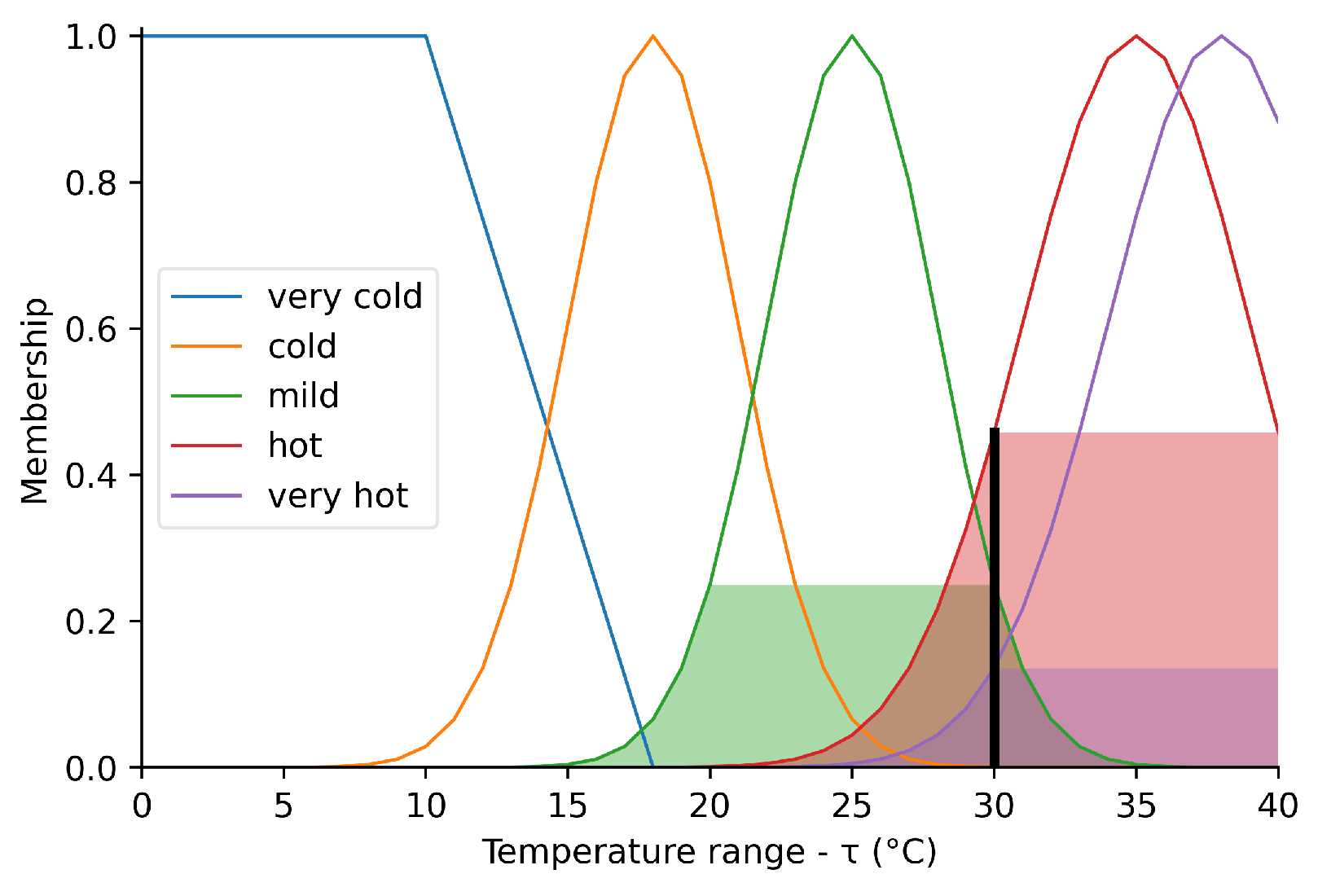
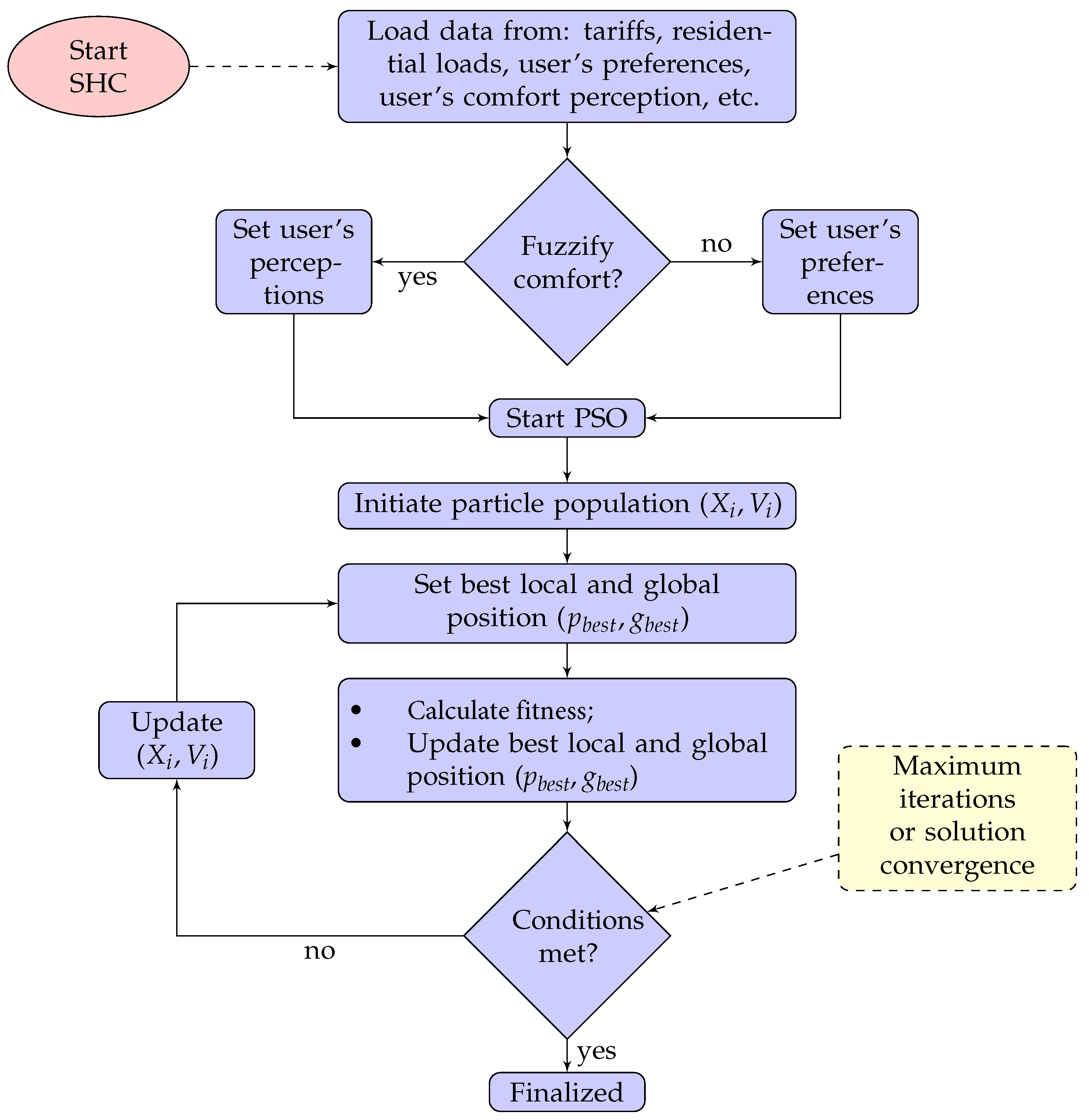
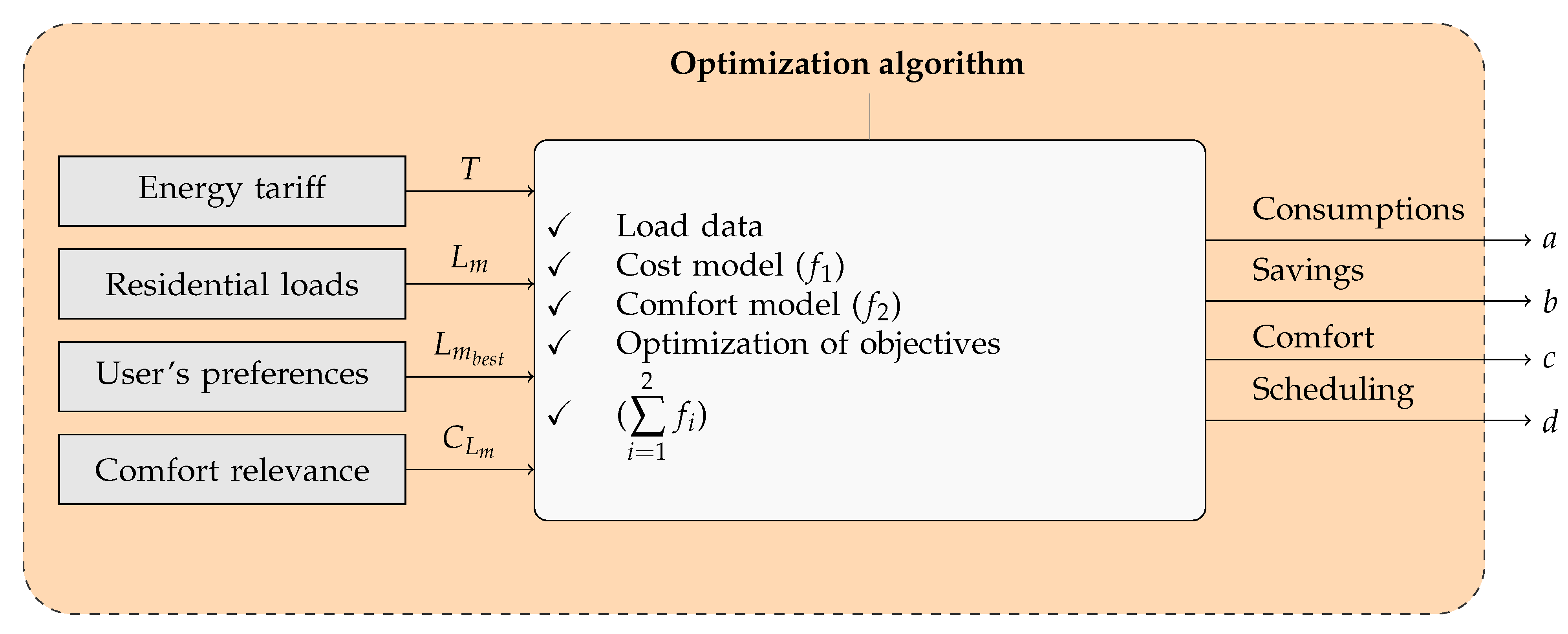

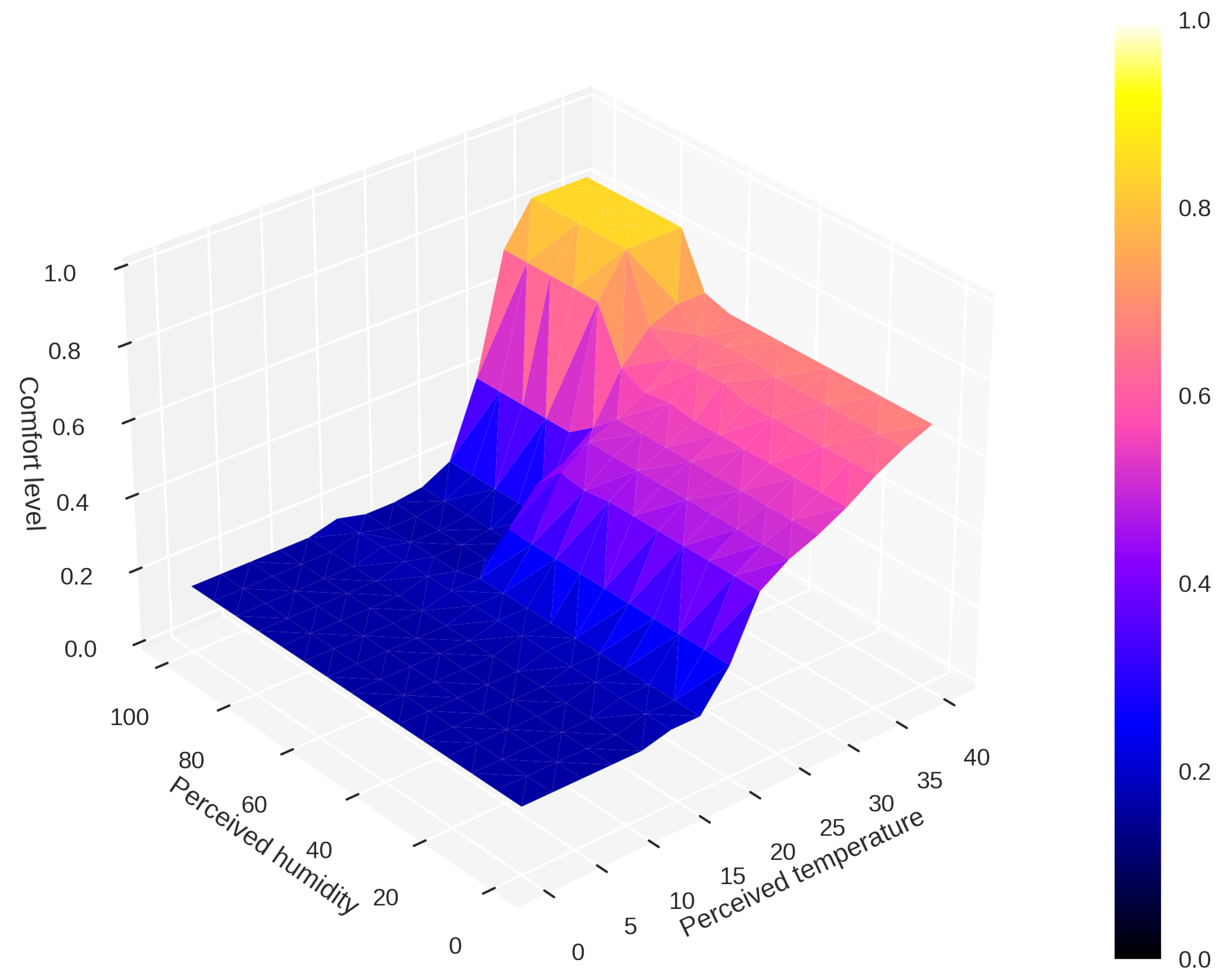
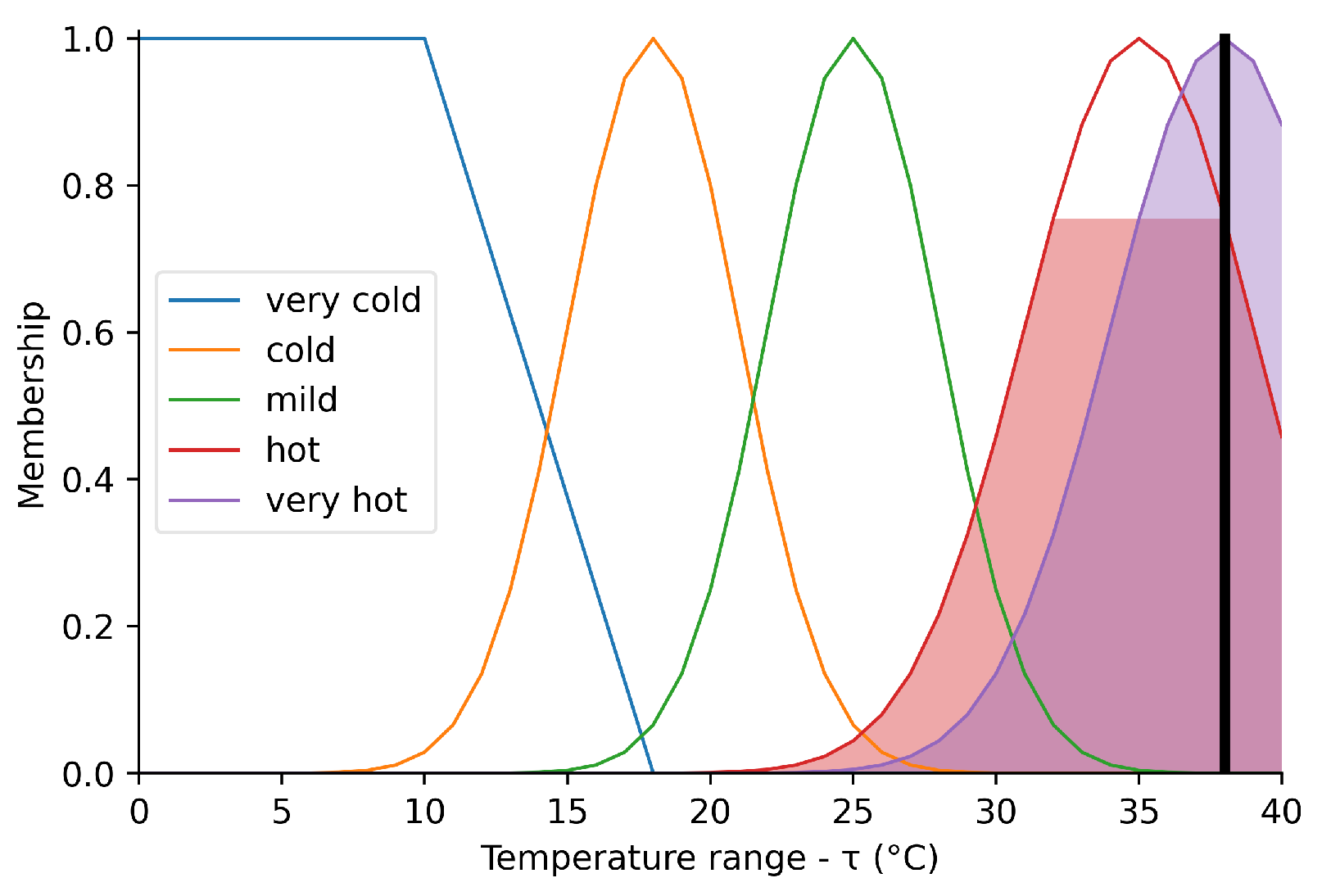
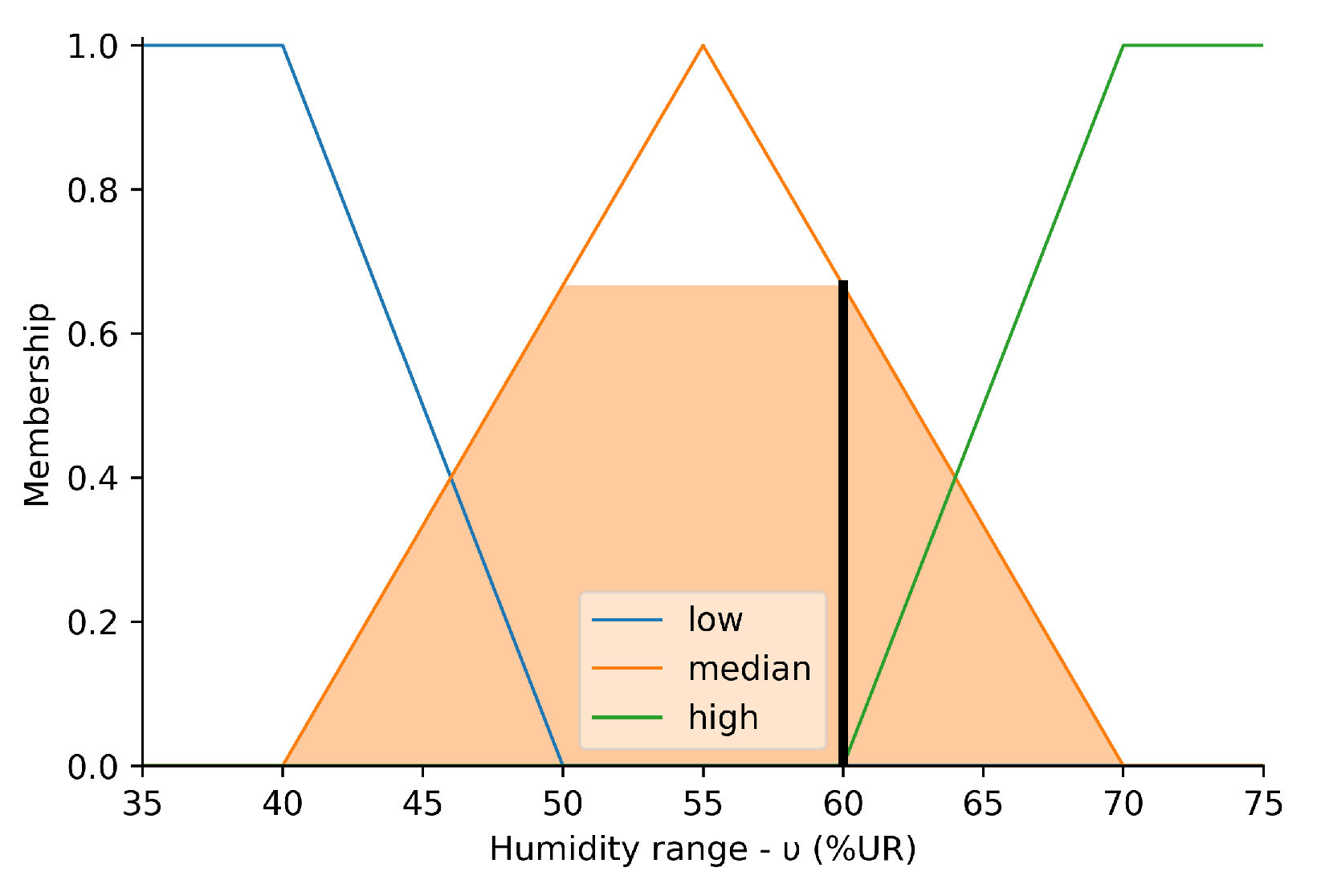
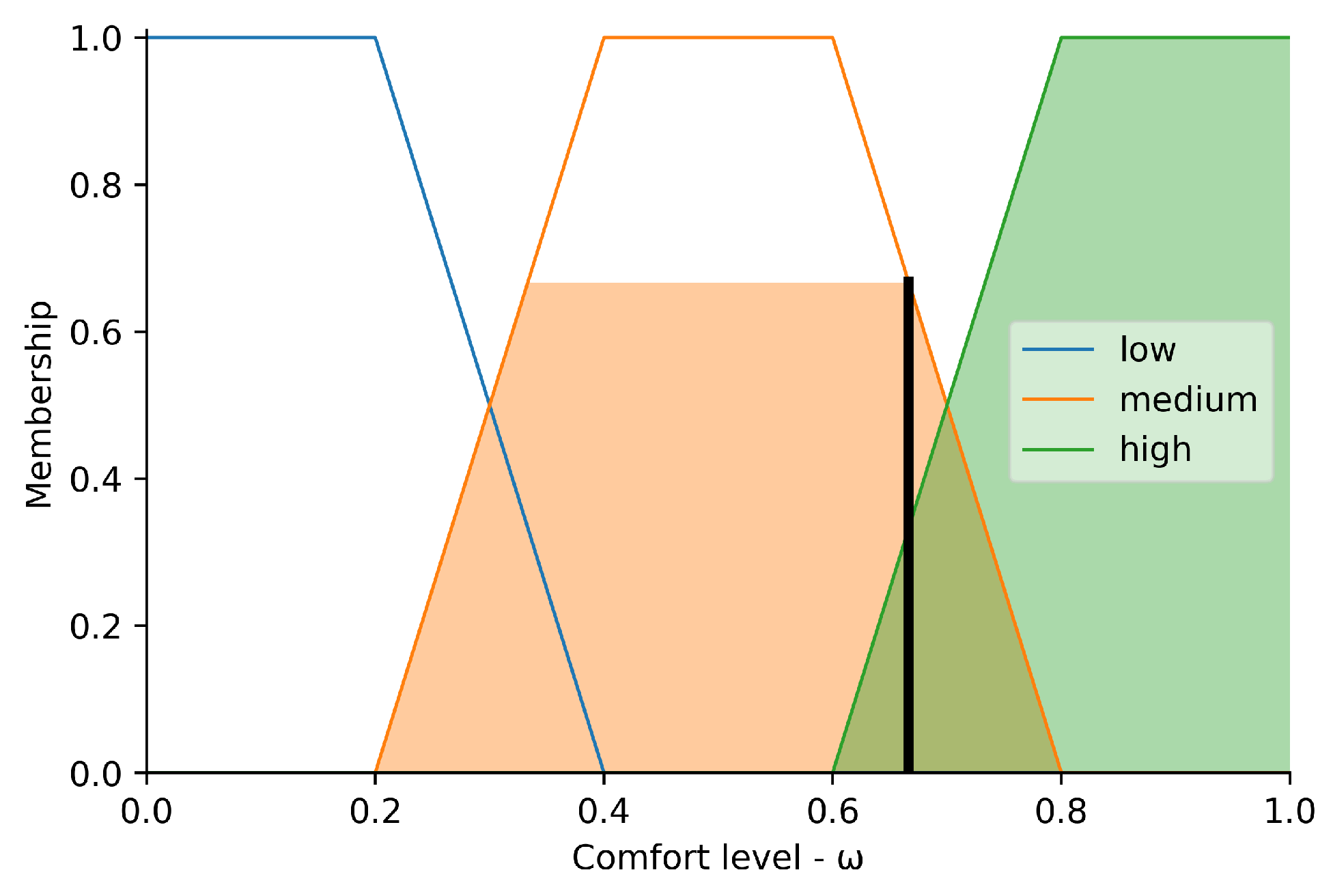
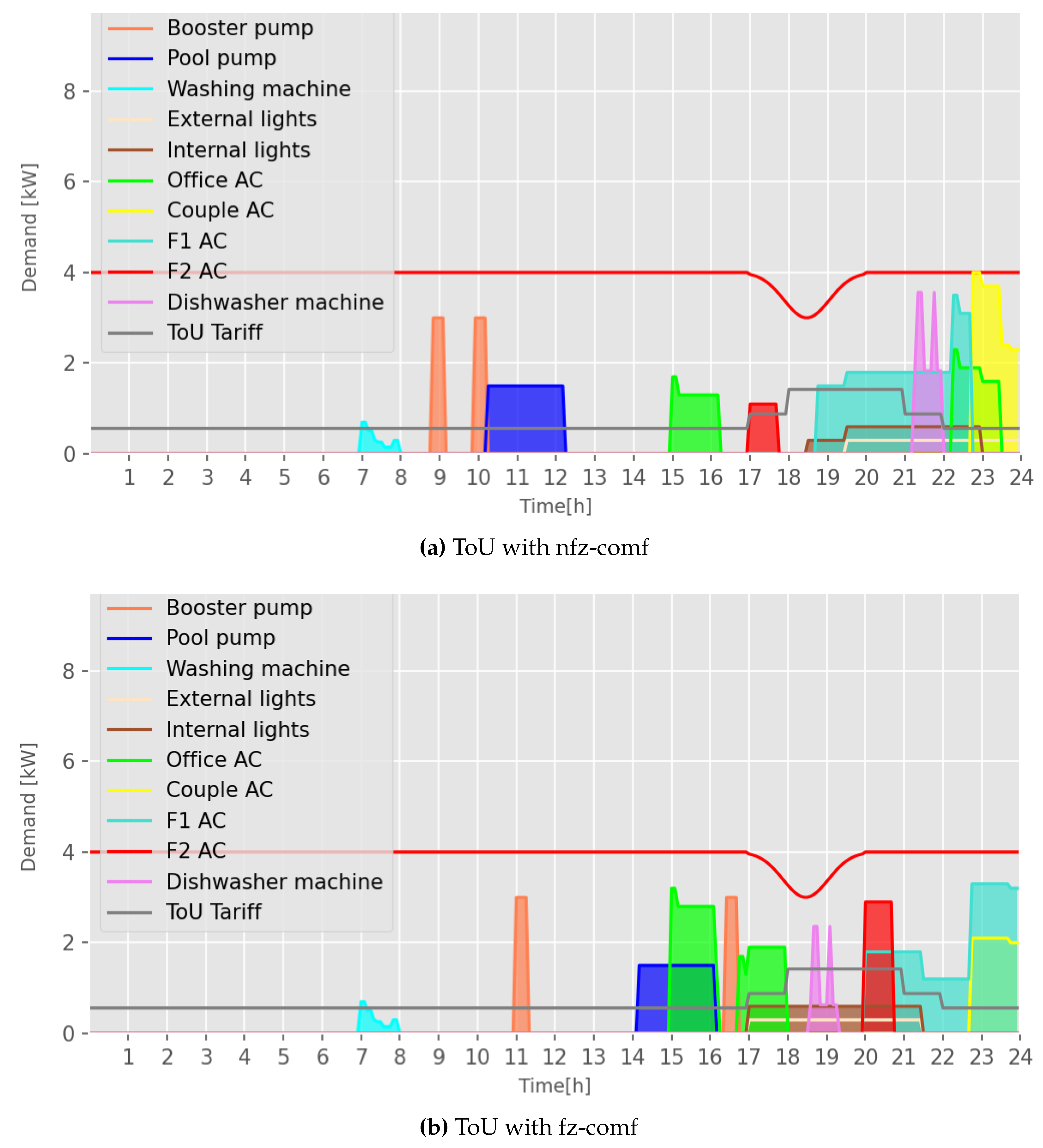
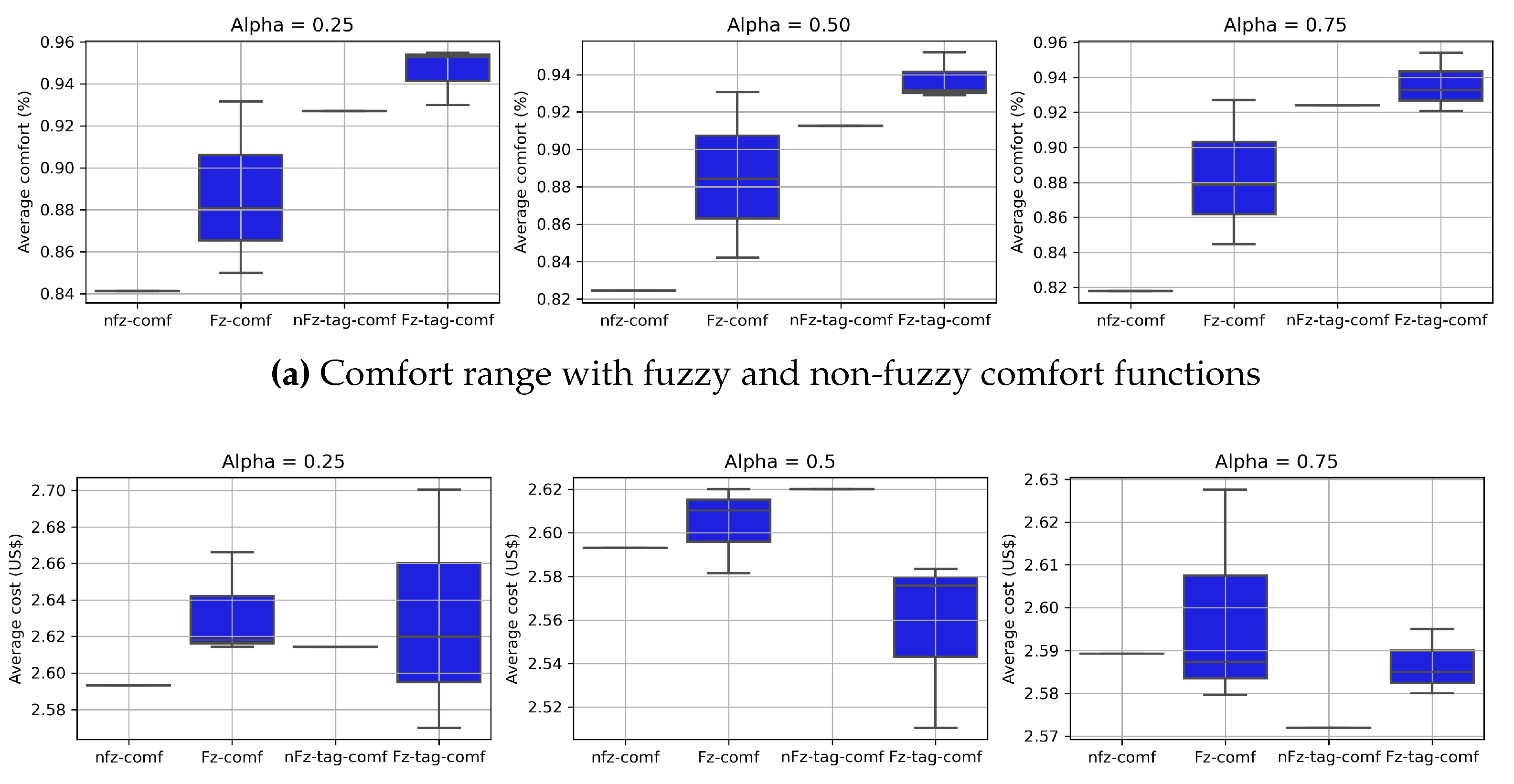
| Period | Tariff | CT | ToU |
|---|---|---|---|
| Mode | (US$/kWh) | (US$/kWh) | |
| 00:00 to 16:30 | Off-peak | 0.136 | 0.112 |
| 16:30 to 17:30 | Intermediate | 0.136 | 0.187 |
| 17:30 to 20:30 | Peak | 0.136 | 0.294 |
| 20:30 to 21:30 | Intermediate | 0.136 | 0.187 |
| 21:30 to 00:00 | Off-peak | 0.136 | 0.112 |
| Id | Description |
|---|---|
| m | Total amount of schedulable loads |
| N | Total amount of samples |
| Average power vector of m-th load | |
| Maximum power vector of m-th load | |
| Duration of the m-th load at sampling | |
| Sample associated with the minimum starting time of the m-th load | |
| Sample associated with the maximum end time of the m-th load | |
| Sample associated with the best starting time of the m-th load | |
| Scheduled start time of the m-th load. | |
| Comfort relevance level of m-th load | |
| Peak limit at k-th time instant | |
| C | Vector referring to the cost of electrical energy during the period. |
| Consumption sampling rate expressed in minutes | |
| Perception of ambient temperature by the user. | |
| Perception of relative humidity by the user | |
| Comfort relevance level of m-th load with user’s perception of |
| Thermal Perception () | ||
| Linguistic Value | Notation | Domain |
| Very cold | [0.00–0.45] | |
| Cold | [0.23–0.68] | |
| Mild | [0.40–0.85] | |
| Hot | [0.58–1.00] | |
| Very hot | [0.65–1.00] | |
| Humidity Perception () | ||
| Linguistic Value | Notation | Domain |
| Low | [0.35–0.50] | |
| Medium | [0.40–0.70] | |
| High | [0.60–0.75] | |
| Comfort Relevance Level () | ||
| Linguistic Value | Notation | Domain |
| Low | [0.0– 0.4] | |
| Medium | [0.2–0.8] | |
| High | [0.6–1.0] | |
| ID | Load | Cycles | (min) | [kw] | [kw] | Best | Min | Max | |
|---|---|---|---|---|---|---|---|---|---|
| Time | Time | Time | |||||||
| 1 | Booster pump | 1 | 20 | 2 | 3 | 8 h or 16 h | 7 h | 17 h | 0.1 |
| 2 | Pool pump | 1 | 120 | 0.75 | 1.2 | 8 h | 7 h | 17 h | 0.1 |
| 3 | Washing machine | 8 | 10,10, 4, 6, 2, 2, 2, 7 | 0.13, 0.50, 0.30, 0.26, 0.15, 0.15, 0.15, 0.22 | 0.70, 0.50, 0.30, 0.26, 0.15, 0.15, 0.15, 0.30 | 8 h | 7 h | 17 h | 0.5 |
| 4 | External lighting | 1 | 270 | 0.3 | 0.3 | 18 h | 17 h | 24 h | 0.3 |
| 5 | Internal lighting | 1 | 270 | 0.15 | 0.3 | 18 h | 17 h | 23 h | 0.7 |
| 6 | Air conditioning 1 | 14 | [10, 5, 5, …, 5, 5] | [1.3, …, 1.3] | [1.7, 1.3, ⋯, 1.3] | 16 h or 20 h | 15 h | 24 h | 1.0 |
| 7 | Air conditioning 2 | 7 | [30, 20, 5, ⋯, 5, 5] | [2, ⋯, 2] | [2.1, ⋯, 2.1] | 20 h | 17 h | 24 h | 1.0 |
| 8 | Air conditioning 3 | 1 | 240 | 1.1 | 1.2 | 20 h | 17 h | 24 h | 1.0 |
| 9 | Air conditioning 4 | 7 | [10, 10, 5, ⋯, 5] | [0.9, ⋯, 0.9] | [1.1, ⋯, 1.1] | 20 h | 17 h | 24 h | 1.0 |
| 10 | Dis hwashing mac hine | 5 | 5, 10, 15, 5, 10 | 0.03, 1.76, 0.03, 1.76, 0.03 | 0.03, 1.76, 0.03, 1.76, 0.03 | 21 h | 18 h | 22 h | 0.3 |
| Id | Load | Gain | ||||
|---|---|---|---|---|---|---|
| 1 | Air cond. | 1.0 | 15 °C | 40% | 0.1639 | ✓ |
| 2 | Air cond. | 1.0 | 25 °C | 45% | 0.4788 | ✓ |
| 3 | Air cond. | 1.0 | 38 °C | 60% | 0.8443 | ✓ |
| Comfort | nfz-comf | fz-comf | nfz-tag-comf | fz-tag-comf | ||||
|---|---|---|---|---|---|---|---|---|
| ∀ | 0.16 | 0.56 | 0.84 | ∀ | 0.16 | 0.56 | 0.84 | |
| 1.18 | 1.20 | 1.20 | 1.18 | 1.20 | 1.21 | 1.20 | 1.21 | |
| 1.22 | 1.23 | 1.22 | 1.22 | 1.23 | 1.24 | 1.23 | 1.23 | |
| 1.24 | 1.26 | 1.25 | 1.24 | 1.26 | 1.27 | 1.26 | 1.26 | |
| Deviation | 0.015 | 0.016 | 0.015 | 0.018 | 0.016 | 0.015 | 0.017 | 0.013 |
| kW/h | 16.4 | 16.4 | 16.4 | 16.4 | 16.4 | 16.4 | 16.4 | 16.4 |
| US$ | 2.593 | 2.666 | 2.618 | 2.614 | 2.614 | 2.570 | 2.700 | 2.619 |
| 84.13% | 93.14% | 88.07% | 84.99% | 92.70% | 95.84% | 95.28% | 92.98% | |
| 4.17 | 3.28 | 3.36 | 2.86 | 3.11 | 3.10 | 2.89 | 2.99 |
| Comfort | nfz-comf | fz-comf | nfz-tag-comf | fz-tag-comf | ||||
|---|---|---|---|---|---|---|---|---|
| ∀ | 0.16 | 0.56 | 0.84 | ∀ | 0.16 | 0.56 | 0.84 | |
| 1.14 | 1.15 | 1.13 | 1.12 | 1.13 | 1.15 | 1.16 | 1.16 | |
| 1.19 | 1.21 | 1.19 | 1.19 | 1.12 | 1.21 | 1.21 | 1.22 | |
| 1.24 | 1.26 | 1.24 | 1.25 | 1.26 | 1.25 | 1.25 | 1.26 | |
| Deviation | 0.027 | 0.029 | 0.030 | 0.030 | 0.035 | 0.028 | 0.027 | 0.026 |
| kW/h | 16.4 | 16.4 | 16.4 | 16.4 | 16.4 | 16.4 | 16.4 | 16.4 |
| US$ | 2.593 | 2.581 | 2.610 | 2.619 | 2.619 | 2.575 | 2.583 | 2.510 |
| 82.43% | 93.06% | 88.43% | 84.19% | 91.25% | 95.17% | 93.13% | 92.89% | |
| 2.78 | 2.68 | 2.84 | 2.44 | 2.51 | 2.82 | 2.59 | 2.47 |
| Comfort | nfz-comf | fz-comf | nfz-tag-comf | fz-tag-comf | ||||
|---|---|---|---|---|---|---|---|---|
| ∀ | 0.16 | 0.56 | 0.84 | ∀ | 0.16 | 0.56 | 0.84 | |
| 1.07 | 1.05 | 1.08 | 1.07 | 1.05 | 1.07 | 1.08 | 1.11 | |
| 1.17 | 1.16 | 1.17 | 1.17 | 1.18 | 1.18 | 1.17 | 1.17 | |
| 1.25 | 1.26 | 1.26 | 1.24 | 1.24 | 1.25 | 1.25 | 1.24 | |
| Deviation | 0.047 | 0.049 | 0.049 | 0.045 | 0.043 | 0.047 | 0.039 | 0.039 |
| kW/h | 16.4 | 16.4 | 16.4 | 16.4 | 16.4 | 16.4 | 16.4 | 16.4 |
| US$ | 2.589 | 2.628 | 2.580 | 2.587 | 2.572 | 2.580 | 2.595 | 2.585 |
| 81.80% | 92.70% | 87.88% | 84.47% | 92.39% | 95.40% | 93.27% | 92.07% | |
| 2.86 | 2.56 | 2.52 | 2.59 | 2.85 | 2.78 | 2.97 | 2.67 |
Disclaimer/Publisher’s Note: The statements, opinions and data contained in all publications are solely those of the individual author(s) and contributor(s) and not of MDPI and/or the editor(s). MDPI and/or the editor(s) disclaim responsibility for any injury to people or property resulting from any ideas, methods, instructions or products referred to in the content. |
© 2023 by the authors. Licensee MDPI, Basel, Switzerland. This article is an open access article distributed under the terms and conditions of the Creative Commons Attribution (CC BY) license (https://creativecommons.org/licenses/by/4.0/).
Share and Cite
Costa, J.R.d.; Barroso, G.C.; Souza, D.A.d.; Batista, J.G.; Souza Junior, A.B.d.; Rios, C.S.d.N.; Vasconcelos, F.J.d.S.; Júnior, J.N.d.N.; Bezerra, I.d.S.; Lima, A.F.d.; et al. An Improved Optimization Function to Integrate the User’s Comfort Perception into a Smart Home Controller Based on Particle Swarm Optimization and Fuzzy Logic. Sensors 2023, 23, 3021. https://doi.org/10.3390/s23063021
Costa JRd, Barroso GC, Souza DAd, Batista JG, Souza Junior ABd, Rios CSdN, Vasconcelos FJdS, Júnior JNdN, Bezerra IdS, Lima AFd, et al. An Improved Optimization Function to Integrate the User’s Comfort Perception into a Smart Home Controller Based on Particle Swarm Optimization and Fuzzy Logic. Sensors. 2023; 23(6):3021. https://doi.org/10.3390/s23063021
Chicago/Turabian StyleCosta, Jonatha Rodrigues da, Giovanni Cordeiro Barroso, Darielson Araújo de Souza, Josias Guimarães Batista, Antonio Barbosa de Souza Junior, Clauson Sales do Nascimento Rios, Felipe José de Sousa Vasconcelos, José Nogueira do Nascimento Júnior, Ismael de Souza Bezerra, Alanio Ferreira de Lima, and et al. 2023. "An Improved Optimization Function to Integrate the User’s Comfort Perception into a Smart Home Controller Based on Particle Swarm Optimization and Fuzzy Logic" Sensors 23, no. 6: 3021. https://doi.org/10.3390/s23063021
APA StyleCosta, J. R. d., Barroso, G. C., Souza, D. A. d., Batista, J. G., Souza Junior, A. B. d., Rios, C. S. d. N., Vasconcelos, F. J. d. S., Júnior, J. N. d. N., Bezerra, I. d. S., Lima, A. F. d., Santana, K. A. d., & Oliveira Júnior, J. R. d. (2023). An Improved Optimization Function to Integrate the User’s Comfort Perception into a Smart Home Controller Based on Particle Swarm Optimization and Fuzzy Logic. Sensors, 23(6), 3021. https://doi.org/10.3390/s23063021






